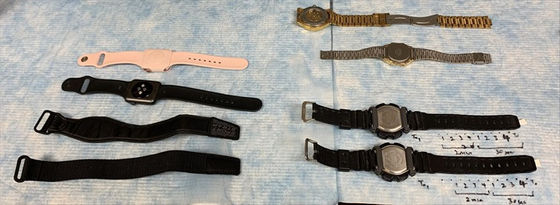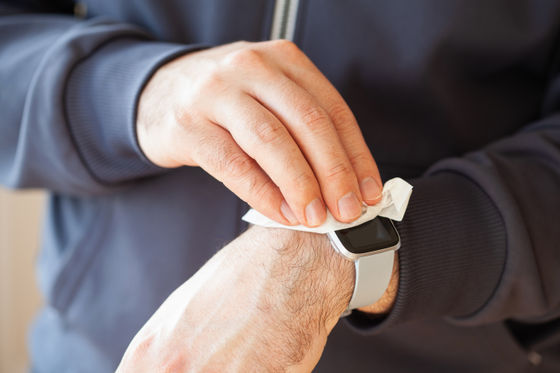Research shows that smart watch straps are ``covered with harmful bacteria''; which material is the best for belts that are less likely to attract pathogens?

A study found that 95% of wristbands for smart watches and fitness trackers were contaminated with harmful bacteria that can cause illness. The research also identified materials for wristbands that are relatively free of germs, as well as cleaning methods that are effective at reducing germs.
Prevalence and Disinfection of Bacteria Associated with Various Types of Wristbands
Smartwatch Bands Are Loaded With Potentially Harmful Bacteria, Study Warns : ScienceAlert
https://www.sciencealert.com/smartwatch-bands-are-loaded-with-potentially-harmful-bacteria-study-warns
Wristbands for devices worn on the wrist, such as watches and fitness trackers, can be used in a variety of situations in daily life, such as when sweating during exercise, while swimming, while interacting with pets, and even while sleeping. It's touching your skin. However, these devices are often not regularly disinfected and can transmit harmful bacteria.
Therefore, a research team at Florida Atlantic University in the United States asked 20 volunteers to provide wristband samples of wrist-worn devices and investigated the pathogens attached to them.
The male-female ratio of volunteers was 12 males and 8 females, and their ages ranged from 19 to 65. Activities and occupations where the wristband is worn include desk work in an office, driving a car, training at CrossFit , firefighting, and veterinarians performing surgery.The wristbands are made of metal, rubber, cloth, plastic, leather, etc. was.

When the research team tested the wristbands for bacteria in the genus Pseudomonas, including
The total amount of bacteria detected varied from wristband to wristband, and there were large variations even among the same materials, but on average, the bacteria were found to be more prevalent in the following order: cloth ≧ plastic ≧ rubber ≧ leather and metal. In other words, metal wristbands tended to have relatively few bacteria on their surfaces. Of the 20 samples, the only one in which no bacteria were detected was a metal wristband made of gold.

Commenting on the results showing that many bacteria were attached to cloth and plastic wristbands, Nwadiwut Esiob, a biological scientist at Florida Atlantic University, said, ``Bacteria can attach to the surface of materials that are porous and easily charged with static electricity. 'This can create an environment suitable for bacterial growth.'
The bacteria tested are common bacteria that exist in the body and the environment, but in some cases they can cause infections such as pneumonia. The propensity for bacteria to accumulate was not affected by the gender of the volunteer who provided the wristband, but the activity while wearing it had a strong influence, with gym-goers' wristbands being particularly susceptible to staph bacteria. I did.
The research team went on to test which cleaning agents were more effective. Three types of disinfectant spray were used in the test: Lysol, an American household disinfectant product brand, 70% ethanol, which is often used in hospitals as an alcohol disinfectant, and apple cider vinegar, which is popular as a natural and organic disinfectant.

Test results showed that all three types were effective on most materials, killing almost all bacteria within 30 seconds, but there were a few exceptions. First of all, looking at the material, the disinfection of plastic wristbands was not effective until 120 seconds, so the research team wrote in the paper, ``How to properly disinfect rough, porous, and sticky surfaces. It emphasizes the need for longer contact times.'
In addition, the only cleaning agents that were effective against staphylococci were disinfectant spray and ethanol, and apple cider vinegar did not significantly reduce the number of staphylococci even after 300 seconds of disinfection.
Summarizing these findings, the research team concluded that 'wristbands are often worn daily without routine cleaning, which can lead to the accumulation of potentially pathogenic bacteria. , showed the need for regular sanitization of the surface of wristbands. Rubber and plastic wristbands generally harbor higher numbers of bacteria, while metal wristbands, especially those made of gold and silver, 'We found that there were little to no bacteria present in the samples.'
Related Posts:







